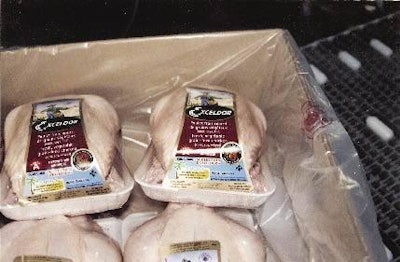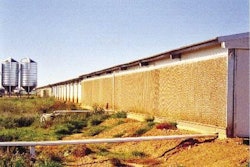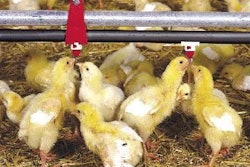
Value-added is a marketer's way of saying that a product has something extra to offer the consumer but, from a production standpoint, value-added usually means cost-added as well. However, if you can get paid a sufficiently high premium for producing a value-added/cost-added product, then value-added can also mean profit-added. One factor that can affect the profitability of a value-added step is the reject rate. Whatever premium is charged for a value-added product, the premium needs to be large enough to cover the extra costs on the first quality and the rejected products.
Company profile and products
Exceldor Cooperative Avicole markets its Exceldor brand chicken products throughout Canada as a premium brand. Two major points of differentiation are used to distinguish its chicken from competitors: Exceldor brand birds are fed a diet excluding animal proteins (vegetable diet') and they are air-chilled. These factors put Exceldor brand chicken at a significant cost disadvantage to its water-chilled, conventionally fed competitors. Water-chilled birds have as much as 7% better slaughter yield than air-chilled birds, and all-vegetable diets have become relatively more expensive as meat and bone meal prices have dropped due to restrictions on feeding ruminant by-products back to ruminants.
Exceldor's major products are whole birds and deboned tray-pack breast meat. These two products make up about 80% of the company's branded sales. Eric Cadoret, vice president of operations, said that the Canadian market as a whole is moving towards more cut-up and more deboned product, and away from whole birds. Because Exceldor sells an air-chilled and vegetable-fed product in their premium brand, the company is bucking the trend towards fewer whole birds. Because of the importance of whole birds in the product mix and because of the cost of air-chilling and the all-vegetable diet, Mr Cadoret emphasised that the company must do a good job of sorting to make sure that all of the birds that are the proper weight and grade make it to the whole-bird packing line. Birds that are the wrong size or do not make the grade end up on the cut-up or deboning lines and may not be sold at a premium price.
Reducing labour and improving accuracy
Exceldor's Saint-Anselme broiler plant, which is located just outside Quebec City, Canada, packs Exceldor brand whole birds. The plant processes 600,000 birds/week or around 8500 birds/hour on two shifts. The plant participates in the Modernised Poultry Inspection Programme (MPIP), which is the Canadian version of HIMP. One high-speed, evisceration line (Maestro; Meyn Food Processing Technology) feeds the air-chiller. Like many older poultry plants, this one has been expanded several times over the years. One expansion took the plant across the street, and the evisceration and pack-out halves of the plant are now connected by a covered corridor that goes over the road.
A single shackle line moves birds out of the air-chiller with the shackles narrowly spaced on 15-cm centres. Before installation of a vision grading system, two employees on each shift graded the birds on-line as they passed at speeds up to 150 birds/minute.
Exceldor began working with GRB Inc. two years ago to employ a vision system to grade the birds and interact with the on-line Chickway scaling system. Mr Cadoret said that within weeks of installing the prototype vision system, it had replaced the graders on both shifts and was grading more accurately. The vision system helps to make sure that all of the top quality grade A birds are packed out to their highest valued use, which in their system is a whole bird. Mr Cadoret identified reducing employee head count in Exceldor's plants as of particular importance for the company, since its hourly wage and benefit cost is one of the highest reported in Agristats in North America.
A third generation GRB PPAV system is in place at the Saint-Anselme plant now. Cameras are used to record digital images of both the front and the back of birds. Because the shackles at Saint-Anselme are on 15-cm centres, the camera that collects images of the front of the birds is located at a turn in the shackle line. The turn in the line allows for the birds to be lifted up slightly and fanned out so that they are not touching each other. This allows a distinct image of each bird to be captured. To minimise glare or reflection, the background material surrounding the camera is made of non-reflective black plastic. The vision system's software analyses the images and grades the birds. Exceldor grades the birds into three different categories but the system can handle up to nine categories and line speeds up to 180 birds/minute.
Mr Cadoret explained that one of the challenges with the vision system came when Exceldor began processing birds that had been fed an all-vegetable diet. The colour of the subcutaneous fat on a chicken carcass varies depending on the bird's diet. Birds fed only with fats from vegetable sources have a lighter colour of fat, which made the skin of the bird more transparent on the images. This, in turn, made skin tears harder for the vision system to detect. With a change to the light spectrum used, the system can now recognise defects in birds fed either diet.
Under-grade birds at the plant are cut-up or deboned. The cut-up system is an older model, which is unable to receive and utilise data from the vision system. Mr Cadoret said that Exceldor is considering putting in a more modern cut-up system that could interact with the vision system and save labour. Exceldor owns one other broiler plant outright in Saint-Damase, near Montreal. That plant is a small-bird cut-up plant with two kill lines and three Systemate intelligent cut-up lines with automatic transfers.
More than one million birds per week
The Exceldor co-operative is 62 years old. The company owns two broiler plants outright Saint-Anselme and Saint-Damase. It is also involved in a partnership with Olymel, and this partnership owns a broiler plant, Giannone Poultry Inc., and a turkey plant, Unidindon Inc. The Saint-Damase plant processes 16,000 birds/hour on one shift/day and processes around 500,000 birds/week. These birds are water-chilled.
Exceldor was the first broiler processor in North America to install an air-chiller in 1994. Now the Saint-Anselme plant air-chills as does Giannone Poultry, which processes 240,000 broilers/week.
Around 40% of the Canadian broiler market is air-chilled today but there is almost no air-chilled turkey in Canada. Unidindon is the only turkey plant in eastern Canada, and it processes 180,000 birds/week, which is made up of 30,000-40,000 toms, 10,000 hens, 60,000-70,000 broiler turkeys, 50,000 roasters and 20,000 fowl. In Canada, a broiler turkey is a small whole bird of either gender from a small-bodied breed or a hen from a large-bodied breed. Exceldor's share of the Unidindon volume is 40,000 turkeys/week.
Exceldor sexes its broilers at hatch, and males and females are raised in different houses. Cockerels are processed at the Saint-Anselme plant at 2.35kg average live weight, and the hens are processed at Saint-Damase at 1.8kg average live weight. Mr Cadoret said that all of the broilers in Quebec are raised in sex-separate housing. For the USA, Agristats reports that less than 5% birds are sexed.
Exceldor's all-vegetable diet programme has grown rapidly, and now 400,000 birds/week are raised this way. All of these birds are males, and all are processed at the Saint Anselme plant. According to Mr Cadoret, Exceldor produces 11% of the broilers and 8% of the turkeys in Canada. The company has sales of Canadian $275 million (US $235 million), and most of these sales are in eastern Canada with half of sales in Quebec and 40% in Ontario.
Canadian industry differs from USA
Separating males and females at hatch and raising them separately is not the only way that on-farm broiler production in Canada differs from the USA. Canadian winters are long, hard and cold. Multi-storey poultry houses are cheaper to heat than single-storey houses. Michel Leclerc, plant manager, Exceldor Saint-Anselme, said that over 80% of Exceldor's birds are raised in multi-storey houses, and it requires a bit more manpower to catch birds in these houses.
Double-decker broiler houses used to be commonplace in the USA as far south as the Delmarva Peninsula and the Shenandoah Valley. As automated cage dumping systems became commonplace at USA plants, integrators have gradually moved away from placing birds in the upper levels of multi-floor houses. In the USA, birds that are still placed on upper floors must be carried by hand to the cages, which are placed with a fork lift at the doorway to the upper floor.
Exceldor uses individual plastic cages, which look like the old wooden crates that were a staple in the USA industry years ago, to carry its broilers to the plant. The cages are unloaded from the truck and hand-carried into the house where they are filled and then carried back to the truck for stacking, a loaded cage weighs around 25kg. At the plant, two employees unload the cages from the truck and put them onto a conveyor that transports the cages to the live hangers. The live hangers open the cages and hang the birds on the line from the cage.
Canada and the USA share many characteristics economically, politically and socially. However, the poultry industries in the two countries have evolved quite differently. A supply management system has been utilised in Canada for over three decades to control the production of broilers, turkeys and eggs. Its aim is to ensure that enough poultry is produced to satisfy consumer demand and provide producers adequate returns on their investments.
















